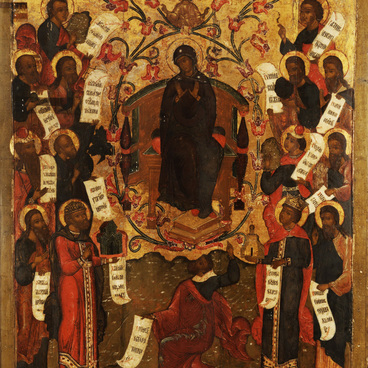The icon Rejoices at You was part of the Church of the Savior in the town of Yaroslavl, built in the second half of the 17th century. The image illustrates the words of the thanksgiving hymns in honor of the Virgin Mary: Every gracious creature rejoices at You… Byzantine theologian John Damascene, who lived in the 8th century, is considered to be the author of the hallelujah psalm. In Russian liturgical practice, the full text of Rejoices at You is sung at the liturgy of Vasily the Great. The main theme of the hymn is the glorification of the Virgin Mary.
Rejoices at You
Creation period
The middle of the 17th century
Dimensions
134x109 cm
Technique
Tempera
Collection
Exhibition
4
Open in app#1
Unknown author
Rejoices at You
#2
#4
The elements of the composition match the words of the psalm. Our Lady is sitting on the throne in the green halo of divine glory - a special glow that was painted on the icons around Jesus and the Virgin Mary. Infant Christ is sitting in her lap and is giving a blessing to the praying person. A dense group of angels surrounds their figures.
#5
The artist painted the human race according to the ranks of holiness at the bottom of the throne, in the lower part of the picture. We can see several rows of praying apostles, martyrs, prophets, sanctifiers and saints. John Damascene, the author of the hymn in honor of the Virgin Mary, is standing at the foot of the throne. He is holding the scroll with the first lines of the hymn.
There is a five-domed cathedral in the clouds, in the upper part of the icon. It is surrounded by an arch that forms the heavenly sphere and the Garden of Eden with blossoming trees. Such a composition was typical for the Russian art of the 16th century. It is a visual metaphor of Heavenly Jerusalem - one of the images of the Kingdom of Heaven.
#6
The iconography of the image had two versions, the Novgorod and the Moscow ones. The one on display is the Moscow version of the icon: the center of the saints’ row shows the figure of John the Baptist and the righteous souls of the dead, who are depicted as haloed babies, wearing white shirts. The human race was depicted in less detail in the Novgorod iconographic tradition.
#7
The icon is made on a four-part board with two coupling keys fastened together. The color scheme of the exhibit in an example of the Yaroslavl icon-painting tradition of the 17th century: various shades of green, red, brown and ochre tones prevail, with the colors alternating in contrasting combinations. The Heavenly Jerusalem is surrounded by a sphere, emanating a golden glow.
#8
The Yaroslavl Museum Reserve
read morehide
00:00
00:00
1x
Rejoices at You
Creation period
The middle of the 17th century
Dimensions
134x109 cm
Technique
Tempera
Collection
Exhibition
4
Open in app
Share

